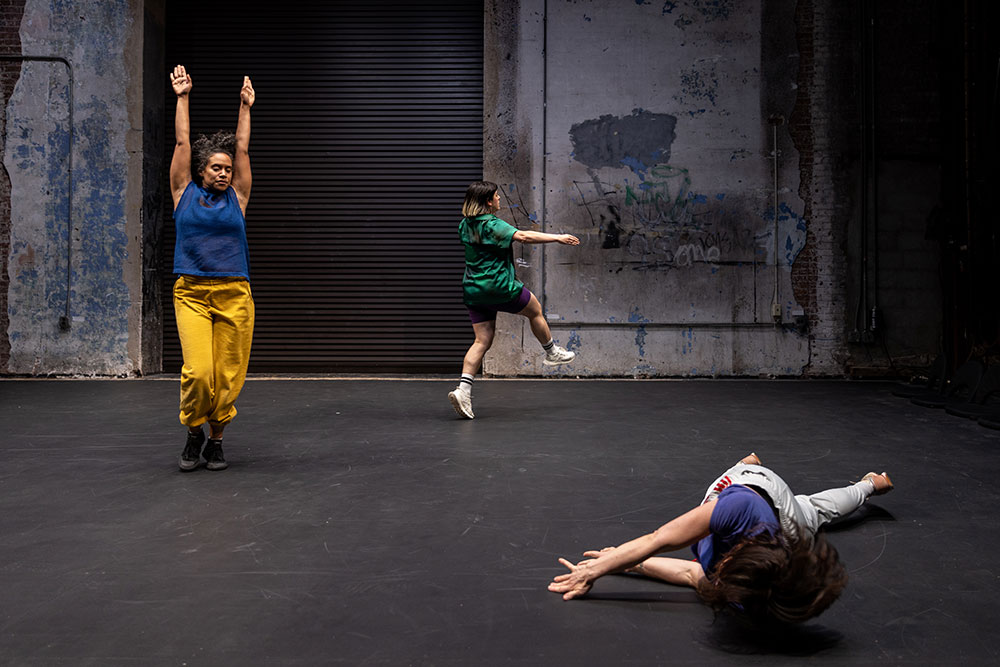I was sitting in my seat when I saw a sensation
Amit Noy, The Brooklyn Rail
Amit Noy, The Brooklyn Rail

In an attempt to understand Family Happiness, I pull my pants down as I’m cooking breakfast. They dribble south to form a cotton swamp around my legs and I cross the apartment like this, heading past corridor-bathroom-second-corridor-office to the bedroom, where the return odyssey begins. I’m both thrilled and bathetic, but mostly unsure what to do. Who can I be with my pants around my ankles?
In Juliana F. May’s new dance Family Happiness, which ran May 3rd through 13th at Abrons Arts Center, the performers lower and raise their pantlegs incessantly, like a latitudinal compass of unreality. As in much of May’s choreography, it’s a gesture that lives at the terrifying junction of things that children and adults both do, for very different reasons. The performers ambulate pantsless as if playing at kindergarten, rearing to copulate, or beginning to lose their minds. Each new repetition prods respectability’s narrow racetrack, until decorum feels as plastic as a greasy dollar slice.
Family Happiness can be described quickly: a twenty-minute dance followed by a twenty-minute song. The piece continues May’s “decades-long investigation into body control and the complicated system of victimhood and perpetration,” which so far has resulted in Commentary=not thing (2013), Adult Documentary (2016), and Folk Incest (2018). Since at least Commentary=not thing, May has been developing a singular approach to choreography, in which a tapestry of pithy gestures unfold without fanfare or indent. A movement, repeated several times, is replaced by a wholly different one, and the changeover is brutally unsentimental—like switching from cutting onion to frying fish. The effect is a bewildering of rational chronology that has as much to do with Yvonne Rainer’s Trio A (that famous flattening) as it does with the Instagram scroll (where you encounter the ostensibly unrelated in rapid succession). The movements themselves excavate the inseparability of geometry and sentiment. They’re highly crafted and physically distinct, yet also possess a psychological tenor. May knows that a form is also a structure of feeling, a way of being toward the world. She stacks movements on top of each other like dinner plates to challenge ideas of behavioral coherence. Rendering emotion into a material, May’s work asks: how could anyone ever feel only one type of way? She fashions an objecthood out of the putty of interiority to remind us (following Kathy Acker) that “‘I’ is a text that is being perpetually rewritten.”
During all this, there are synthesizer fanfares befitting a vintage video game, along with some drums and low bleats for drive and the occasional unsettling addition of high-pitched noises. (The sound design is by Tatyana Tenenbaum.) The dancers also make noises with their mouths, or roll their tongues. Sections of movement repeat, but the dominant impression is of the performers going and going, relentlessly but dispassionately.
To this viewer, May’s dances often seem to hone in on a particular arena of trouble—the precarity of romantic relationships (Commentary=not thing), the specter of pedophilia (Adult Documentary), or the weight of sexual trauma (Folk Incest). In watching Family Happiness, I’m brought to the scene of everyday exhaustion: the undying overwhelm of keeping on going. It’s not the emergency we’re thrust into, but the recovery, collapse, surrender, and dissent that sutures the before and after of crisis time. The dance doesn’t obey the logic of a climax: a performer collapses in a cockroach death (on their back, legs in the air) only to get up two seconds later; a diagonal procession by the group dissolves as quickly as it formed. Two performers interlock in a wrestling hold, and then circle each other’s head with their own in an intimate caress. At the same time, Family Happiness does engage with the titillation of obvious meaning. Tatyana Tenenbaum’s score begins with a recurring heraldic motif in a tone both brassy and plastic. It’s the fanfare of a Disney ballad’s climax, but punctured, so all the air drains out. Later parts feature rhythmic pulsations of breath and dreamlike string melodies before dispersing into a Lynchian fog in the final section. Tenenbaum’s score traverses the same affectual gamut as May’s choreography and shares its lapidary beauty.
The five performers of Family Happiness are remarkable in their simultaneous intensity and ambivalence. They’re utterly devoted to the physical work whilst knowing that a gesture is also an entrapment, a way to subjugate the body to a will outside itself. Each inhabits the piece with a particular approach. Lucy Kaminsky, the shrewdest actor, surfs the wave bridging vulnerability and empowerment. Tess Dworman works crass naïveté to its vertiginous extreme. The candor of Leslie Cuyjet’s presence is so forceful that when she stands in front of me and sings, I am stricken dumb. Like in other works of May (this is their third collaboration), Kayvon Pourazar’s performance makes the room vibrate with an infinitesimal disquiet that is quietly virtuosic. Watching Molly Poerstel razes our sense of our selves to the ground. She dances with a spiritual austerity that cuts to the heart of the matter, as if she’s seen the end of the world and knows it’s already begun. The first part of Family Happiness finishes with Poerstel holding a penché (imagine the splits but on a right angle, with your face to the ground and your back leg in the air). In vigorous stillness, only her lungs move to breath. It’s as if her ribs are crying.
I was walking down the street and I saw a sensation
I said hello how ARE you feeling in that dark small space between MY EYES,
I saw YOU TALKING to another person
I want to be in your head that’s not YOUR EARS your ASS is PUSHING my brain down,
inside THAT HOLE
So begins the second part of Family Happiness. The odyssean melody unspools as the edges of the room (lit by Chloë Z Brown) begin to soften. At some times the song is ingenuous (“I want to be your friend because you you want to be mine”), at others it is droll (“I am fine / I am at the beach / Being low at the beach is fine”), and occasionally it is adult (“You stick your pole up in my ass / Go slow / Go slow”), but humor is the disarming baseline. The veracity of the text is set adrift by the melodic structure, which dips in and out of different time signatures at the behest of an invisible breeze. May’s writing is alternatively opaque and transparent, but always astutely sincere. (“Sitting in a tight little ass chair seat / is a jew—we’re ok—we’re ok to the left is a / dog at the brunch.”). As in Greek theater, the chorus becomes a collective ‘I’ that dexterously slides between modes of feeling and address. May makes clear the murkiness of any sense of yourself in the world with other people. Song can set you spinning in joyful doubt.
Amit Noy for The Brooklyn Rail, June 2023.





























